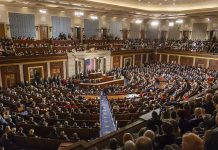
In a decisive blow to activist judges, the Supreme Court’s 6-3 ruling in Trump v. Casa eliminates nationwide injunctions, reclaiming constitutional authority from lower courts and returning significant power to President Trump’s administration.
Key Takeaways
- The Supreme Court ruled 6-3 that nationwide injunctions exceed federal courts’ authority, ending a judicial practice that has repeatedly obstructed presidential policies.
- Justice Amy Coney Barrett’s majority opinion established that universal injunctions are not supported by historical precedent or the powers granted under the Judiciary Act of 1789.
- The ruling dramatically shifts the legal landscape, requiring challengers to pursue class action lawsuits rather than finding a sympathetic judge to block national policies.
- President Trump hailed the decision as a “monumental victory for the Constitution, the separation of powers, and the rule of law.”
- The decision preserves executive authority while requiring legal challenges to be properly tailored to actual plaintiffs with standing.
Supreme Court Reclaims Constitutional Balance
The Supreme Court has delivered a landmark ruling that fundamentally reshapes the boundaries of judicial power in America. In a decisive 6-3 decision, the Court determined that federal district judges cannot issue nationwide injunctions to block presidential policies, effectively ending a practice that has hampered executive action for decades. The ruling stems from challenges to President Trump’s executive order on birthright citizenship but focuses specifically on the procedural question of nationwide injunctions rather than the citizenship issue itself.
Justice Amy Coney Barrett, writing for the conservative majority, delivered a clear rebuke to the practice of nationwide injunctions, asserting that they exceed the authority granted to federal courts. “Universal injunctions likely exceed the equitable authority that Congress has given to federal courts,” Barrett wrote in the majority opinion. This position draws on historical precedent and constitutional principles that limit judicial remedies to the actual parties in a case rather than extending them across the entire nation.
NEW: In Trump v. CASA, a case about the universal injunctions putting the president's order on birthright citizenship on hold nationwide, the Supreme Court grants the government's applications to partially stay the injunctions from district courts.
— SCOTUSblog (@SCOTUSblog) June 27, 2025
Presidential Victory and Liberal Dissent
President Trump celebrated the ruling as a “monumental victory for the Constitution, the separation of powers, and the rule of law.” The decision effectively prevents activist judges from unilaterally blocking presidential policies, returning significant authority to the executive branch. The ruling addresses a long-standing conservative complaint about liberal judges in places like Hawaii or California issuing nationwide blocks on Trump administration policies, a practice that has frustrated conservative governance for years.
“No one disputes that the executive must follow the law, but the judiciary does not have unbridled authority to enforce this obligation. Sometimes the law prohibits the judiciary from doing so,” Justice Amy Coney Barrett wrote in the majority opinion.
The liberal wing of the Court responded with sharp dissent. Justice Ketanji Brown Jackson claimed the decision represents “an existential threat to the rule of law,” suggesting it would allow unconstitutional executive actions to proceed unchecked. Justice Barrett directly addressed this criticism with a powerful rejoinder, writing: “We will not dwell on JUSTICE JACKSON’s argument, which is at odds with more than two centuries’ worth of precedent, not to mention the Constitution itself. We observe only this: JUSTICE JACKSON decries an imperial Executive while embracing an imperial Judiciary.”
Shifting Legal Strategies
The Supreme Court’s ruling fundamentally changes how legal challenges to executive actions will proceed. Going forward, plaintiffs seeking broad relief against government policies must file class action lawsuits rather than relying on a single sympathetic judge to impose nationwide blocks. This ensures that judicial remedies are properly tailored to actual parties with legitimate standing, rather than extending to parties who haven’t even joined the litigation.
“An injunction is an order by a court telling somebody to do something or not do something,” explained Samuel Bray, a legal expert quoted in coverage of the decision.
The decision effectively ends the practice of “forum shopping,” where opposition groups would seek out favorable jurisdictions to file lawsuits blocking national policies. This practice had become a favored tool of leftist organizations hoping to impede conservative governance through judicial activism. Now, legal challenges must demonstrate genuine standing and common injuries among a class of plaintiffs, raising the bar for those seeking to obstruct presidential authority through the courts.
Constitutional Order Restored
This ruling represents a significant victory for constitutional governance and the separation of powers. By limiting the authority of district courts to issue nationwide injunctions, the Supreme Court has restored the proper balance between the branches of government. The decision allows the Trump administration to implement policies without being hamstrung by individual judges overstepping their constitutional role, while still preserving appropriate judicial review when properly pursued.
Justice Barrett’s opinion also highlighted the historical basis for the Court’s decision, noting that universal injunctions were not part of the judicial authority granted by the Judiciary Act of 1789. This return to constitutional originalism represents a victory for those who believe in adhering to the Founders’ vision of limited government and appropriate separation of powers, rather than allowing judges to create new powers for themselves that exceed their constitutional authority.






